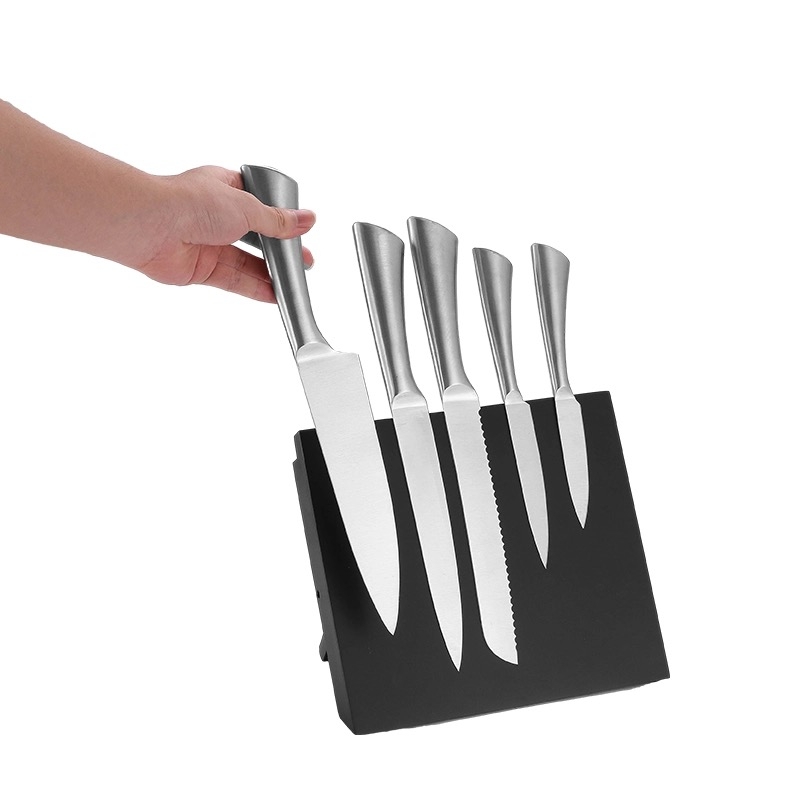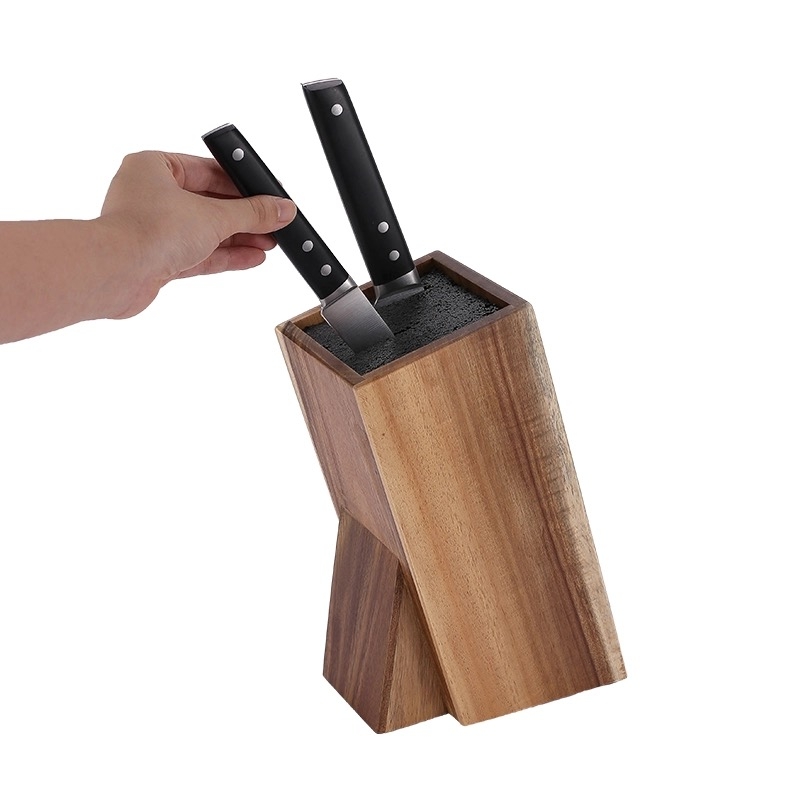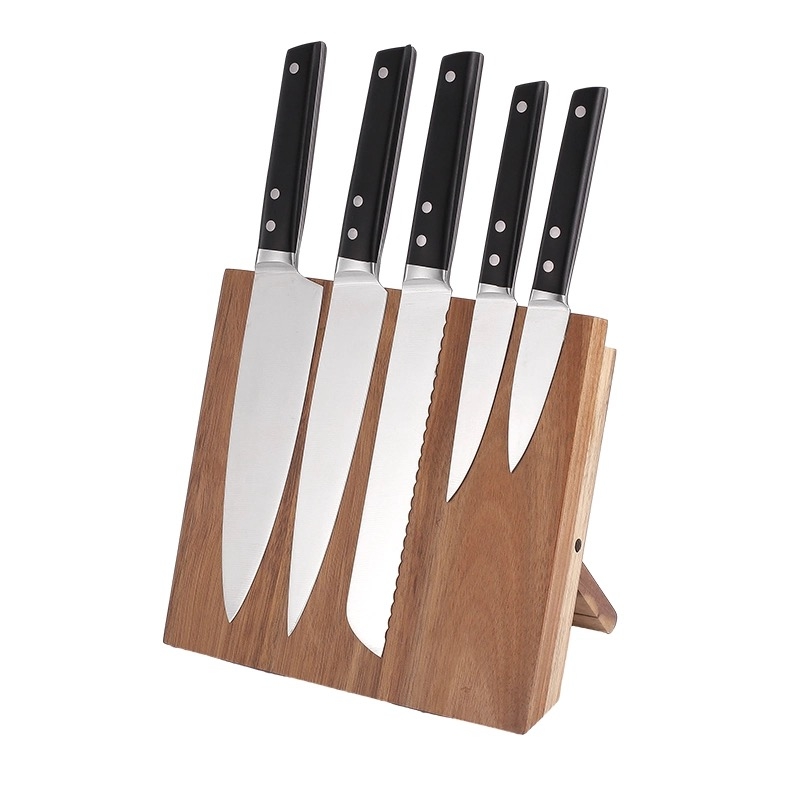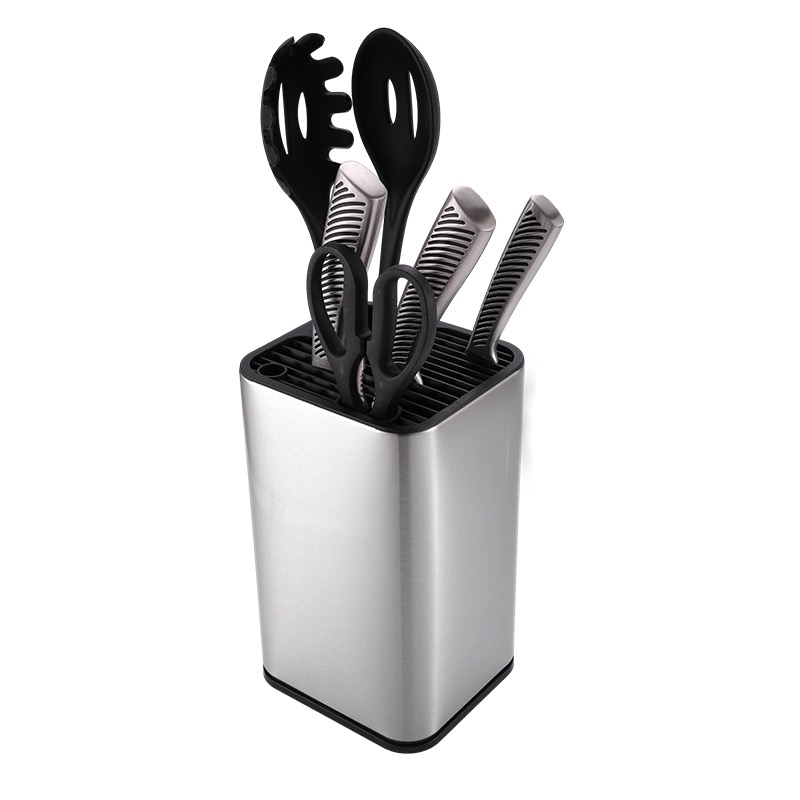Storing knives safely is crucial for both the longevity of the blades and the safety of those using them. A well-organized knife holder not only protects the knives but also enhances the efficiency of your kitchen. In this article, we will explore various types of knife holders, their benefits, and best practices for knife storage.
Understanding Knife Holders
What is a Knife Holder?
A knife holder is a storage solution designed specifically for knives. It can come in various forms, including blocks, magnetic strips, drawer inserts, and wall-mounted racks. The primary purpose of a knife holder is to keep knives organized, accessible, and protected from damage. Each type of knife holder serves a unique purpose and can cater to different kitchen layouts and personal preferences. Understanding the various options available can help you make an informed decision about which type best suits your needs.
Importance of Using a Knife Holder
Using a knife holder is essential for several reasons. First, it helps maintain the sharpness of the blades by preventing them from coming into contact with hard surfaces that can dull them. Dull knives not only make cooking more difficult but can also be dangerous, as they require more force to cut through food, increasing the risk of slips and accidents. Second, it enhances safety by keeping blades covered and out of reach of children. A well-organized knife holder can significantly reduce the chances of accidental cuts or injuries. Lastly, a knife holder can contribute to a more organized kitchen, making it easier to find the right knife when needed. An organized kitchen not only improves efficiency but also creates a more enjoyable cooking environment.

Types of Knife Holders
Knife Blocks
Knife blocks are one of the most common types of knife holders. They are typically made of wood or plastic and feature slots for different knife sizes. The design of knife blocks can vary widely, from traditional wooden blocks to modern, sleek designs that fit contemporary kitchen aesthetics.
Advantages of Knife Blocks
Knife blocks offer several advantages. They provide a stable and secure way to store knives, preventing them from sliding around. This stability is particularly important in busy kitchens where movement can lead to accidents. Additionally, they can be aesthetically pleasing, adding a decorative element to your kitchen countertop. Many knife blocks are designed to complement kitchen decor, making them not just functional but also a part of your kitchen's design.
Disadvantages of Knife Blocks
However, knife blocks can also have downsides. They can take up valuable counter space, which may be a concern in smaller kitchens. Furthermore, if not cleaned regularly, they can harbor bacteria. It is essential to clean knife blocks periodically to prevent the buildup of food particles and moisture, which can lead to mold and unpleasant odors.
Magnetic Knife Holders
Magnetic knife holders are a modern solution for knife storage. They consist of a magnetic strip that can be mounted on a wall or the side of a cabinet. This type of holder is particularly popular in contemporary kitchens where space is at a premium.
Benefits of Magnetic Knife Holders
These holders allow for easy access to knives and can save counter space. By utilizing vertical space, magnetic holders can free up valuable countertop real estate for food preparation and other kitchen tasks. They also keep knives visible, making it easier to select the right one for the task at hand. The visibility of knives can also encourage proper knife usage, as users can quickly identify which knife is best suited for their needs.
Considerations for Magnetic Holders
While magnetic holders are convenient, they require careful installation to ensure that knives do not fall. Proper mounting is crucial to avoid accidents, especially in busy kitchens. Additionally, they may not be suitable for all knife types, particularly those with non-magnetic materials. It is important to check the compatibility of your knives with magnetic holders before making a purchase.

Drawer Inserts
Drawer inserts are designed to fit inside kitchen drawers, providing a safe and organized way to store knives. These inserts can be made from various materials, including plastic, wood, or silicone, and are designed to keep knives separated and secure.
Advantages of Drawer Inserts
They keep knives out of sight, which can be a safety feature in homes with children. By storing knives in drawers, you can minimize the risk of accidental cuts or injuries. Drawer inserts can also maximize space and keep knives protected from damage. This method of storage can help prevent knives from clashing against each other, which can dull the blades over time.
Limitations of Drawer Inserts
However, accessing knives stored in drawers can be less convenient than other methods. It may require more effort to keep the drawer organized, especially if you have a large collection of knives. Additionally, if the drawer is not deep enough, it may be challenging to store larger knives securely.
Wall-Mounted Racks
Wall-mounted racks are another option for knife storage. These racks can hold knives securely while keeping them easily accessible. They can be made from various materials, including wood, metal, or acrylic, and can be designed to match your kitchen's style.
Benefits of Wall-Mounted Racks
They save counter space and can be a stylish addition to kitchen decor. Wall-mounted racks can serve as a focal point in your kitchen, showcasing your knife collection while keeping them organized. They also allow for easy visibility and access to knives, making it simple to grab the right tool when you need it.
Potential Drawbacks
The main drawback is that they require wall space and may not be suitable for all kitchen layouts. If your kitchen lacks wall space or has a layout that does not accommodate wall-mounted storage, this option may not be feasible. Additionally, if not installed correctly, they can pose a safety risk. It is essential to ensure that the rack is securely mounted to prevent knives from falling.

Best Practices for Storing Knives
Keep Knives Clean and Dry
Before storing knives, ensure they are clean and dry. Moisture can lead to rust and damage, so it is essential to wipe them down after washing. Using a soft cloth to dry knives thoroughly can help maintain their appearance and functionality. Regular cleaning not only prolongs the life of the knives but also ensures that they are safe to use.
Organize by Size and Use
When storing knives, consider organizing them by size and frequency of use. Place the most commonly used knives in easily accessible locations, while less frequently used knives can be stored further back or in less accessible holders. This organization can streamline your cooking process, allowing you to quickly find the right knife without rummaging through a cluttered storage solution.
Regular Maintenance
Regularly check your knife storage solution for cleanliness and organization. This includes cleaning knife blocks, ensuring magnetic strips are securely mounted, and checking drawer inserts for any signs of wear. Maintenance is key to ensuring that your knife storage remains effective and safe. Additionally, sharpening knives regularly can enhance their performance and safety.
Safety Considerations
Always store knives out of reach of children. If using a magnetic strip or wall-mounted rack, ensure that it is installed at a height that is not accessible to young children. Educating family members about knife safety and proper storage practices can further enhance safety in the kitchen. Additionally, consider using knife guards or sheaths for added protection. These accessories can help prevent accidental cuts when reaching for knives and can also protect the blades from damage.
Conclusion
Storing knives safely is an essential aspect of kitchen organization and safety. By choosing the right knife holder and following best practices for storage, you can ensure that your knives remain sharp, safe, and easily accessible. Whether you opt for a traditional knife block, a modern magnetic holder, or a convenient drawer insert, the key is to find a solution that works best for your kitchen and lifestyle. Investing time and effort into proper knife storage will not only enhance your cooking experience but also contribute to a safer kitchen environment.

Frequently Asked Questions regarding Knife Holder
1. What is the best way to clean a knife block?
To clean a knife block, first remove all knives and use a damp cloth to wipe down the exterior. For the interior, use a soft brush or a vacuum with a brush attachment to remove any debris. If necessary, you can use a mild soap solution to clean the block, but ensure it is completely dry before reinserting the knives.
2. How often should I sharpen my kitchen knives?
The frequency of sharpening kitchen knives depends on usage. For home cooks who use their knives regularly, sharpening every few months is typically sufficient. Professional chefs may sharpen their knives weekly or even daily. It's also important to hone knives regularly to maintain their edge between sharpenings.
3. Are magnetic knife holders safe for children?
Magnetic knife holders can be safe for children if installed out of their reach. However, it is essential to educate children about knife safety and ensure that they understand the dangers of sharp objects. Always supervise young children in the kitchen to prevent accidents.
4. Can I store my knives in a drawer without a knife insert?
While you can store knives in a drawer without an insert, it is not recommended. Without an insert, knives can clatter against each other, leading to dull blades and potential injuries. Using a drawer insert or knife sheath can help protect the blades and keep them organized.
5. What types of knives should I store together?
It is best to store knives of similar types together. For example, keep chef's knives, paring knives, and utility knives in one section, while serrated knives can be stored separately. This organization helps prevent damage and makes it easier to find the right knife for specific tasks.






